display CHEVROLET KODIAK 2008 User Guide
[x] Cancel search | Manufacturer: CHEVROLET, Model Year: 2008, Model line: KODIAK, Model: CHEVROLET KODIAK 2008Pages: 384, PDF Size: 5.4 MB
Page 174 of 384

Playing a Cassette Tape
The tape player is built to work best with tapes that are
up to 30 to 45 minutes long on each side. Tapes
longer than that are so thin they might not work well in
this player. The longer side with the tape visible
should face to the right. If you hear nothing or hear a
garbled sound, the tape might not be in squarely.
Press the
Z(eject) button to remove the tape and
start over.
If the ignition and the radio are off, press the eject
button or the RCL knob to insert and to begin play of a
tape. If the ignition is on and the radio is off, the
tape can be inserted and begins playing. CAS (cassette)
displays when a tape is inserted.
While the tape is playing, use the VOL, AUDIO, and
SEEK controls just as you do for the radio. The radio
displays UP if the top side of the tape is playing.
DN (Down) appears if the bottom side is playing.
The tape player plays the other side of the tape when
it reaches the end.Cassette tape adapter kits for portable CD players
works in the cassette tape player. See “CD Adapter Kits”
later for more information.
The tape bias is set automatically when a metal or
chrome tape is inserted.
If an error displays, see “Cassette Tape Messages” later
in this section.
1 PREV (Previous):The tape must have at least
three seconds of silence between each selection for
previous to work. Press this pushbutton to go to
the previous selection on the tape if the current selection
has been playing for less than three seconds. If pressed
when the current selection has been playing from
three to 13 seconds, it goes to the beginning of the
previous selection or the beginning of the current
selection, depending on the position on the tape.
If pressed when the current selection has been playing
for more than 13 seconds, it goes to the beginning
of the current selection. Pressing this pushbutton
multiple times increases the number of selections to
be searched back, up to−9. Pressing the NEXT
pushbutton cancels the selections.
3-54
Page 175 of 384

2 NEXT:The tape must have at least three seconds of
silence between each selection for next to work.
Press this pushbutton to go to the next selection on the
tape. Pressing this pushbutton multiple times in the
next mode increases the number of selections to
be searched forward. Pressing the PREV pushbutton
cancels the selections.
3 REV (Reverse):Press to quickly reverse the tape.
FR displays. The radio plays while the tape reverses.
Press it again to return to playing speed. Select stations
during reverse operation by using the TUNE or SEEK
controls or by using the scan or preset scan features.
4 FWD (Forward):Press to quickly advance the
tape. FF displays. The radio plays while the tape
advances. Press again to return to playing speed.
Select stations during forward operation by using the
TUNE or SEEK controls or by using the scan or preset
scan features.
5 SIDE:Press to play the other side of the tape.6 RPT (Repeat):The tape must have at least three
seconds of silence between each selection for repeat to
work. Press and release to hear a selection over again.
RPT displays. Press again to turn off repeated play.
OFF displays.
oSEEKp:The tape must have at least three
seconds of silence between each selection for seek to
work. The left arrow is the same as the PREV
pushbutton and the right arrow is the same as the
NEXT pushbutton. If either the left or right arrow is
held or pressed more than once, the player continues
moving backward or forward through the tape.
AM FM:Press to listen to the radio when a tape is
playing. The inactive tape remains inside the radio for
future listening.
TAPE:Press to play a cassette tape when listening to
the radio. CAS displays when a tape is loaded.
Z(Eject):Press to eject a tape. Eject can be
activated with the radio off. Cassette tapes can be
loaded with the ignition and radio off if this button
is pressed first.
3-55
Page 176 of 384
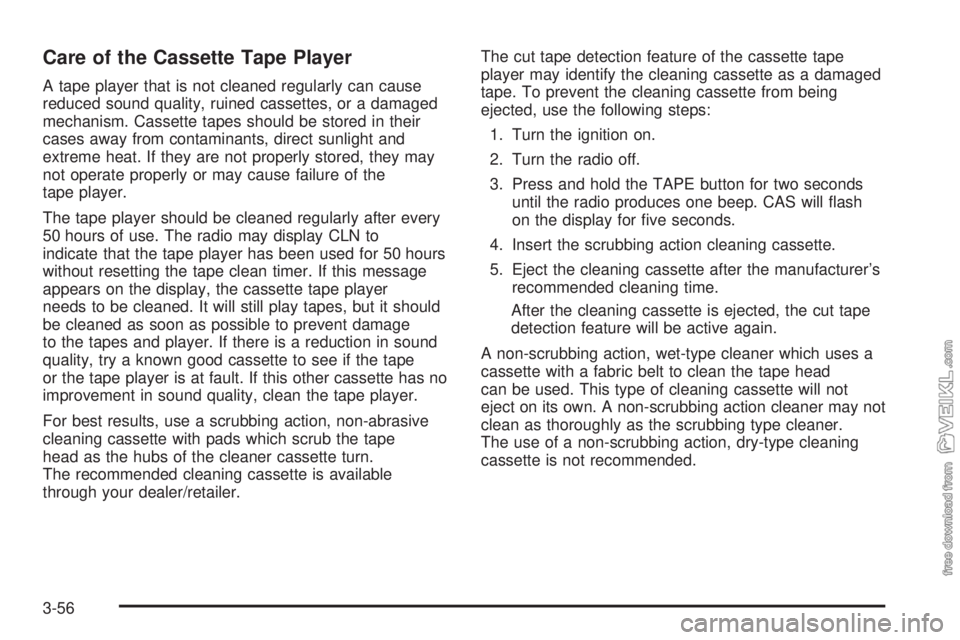
Care of the Cassette Tape Player
A tape player that is not cleaned regularly can cause
reduced sound quality, ruined cassettes, or a damaged
mechanism. Cassette tapes should be stored in their
cases away from contaminants, direct sunlight and
extreme heat. If they are not properly stored, they may
not operate properly or may cause failure of the
tape player.
The tape player should be cleaned regularly after every
50 hours of use. The radio may display CLN to
indicate that the tape player has been used for 50 hours
without resetting the tape clean timer. If this message
appears on the display, the cassette tape player
needs to be cleaned. It will still play tapes, but it should
be cleaned as soon as possible to prevent damage
to the tapes and player. If there is a reduction in sound
quality, try a known good cassette to see if the tape
or the tape player is at fault. If this other cassette has no
improvement in sound quality, clean the tape player.
For best results, use a scrubbing action, non-abrasive
cleaning cassette with pads which scrub the tape
head as the hubs of the cleaner cassette turn.
The recommended cleaning cassette is available
through your dealer/retailer.The cut tape detection feature of the cassette tape
player may identify the cleaning cassette as a damaged
tape. To prevent the cleaning cassette from being
ejected, use the following steps:
1. Turn the ignition on.
2. Turn the radio off.
3. Press and hold the TAPE button for two seconds
until the radio produces one beep. CAS will flash
on the display for five seconds.
4. Insert the scrubbing action cleaning cassette.
5. Eject the cleaning cassette after the manufacturer’s
recommended cleaning time.
After the cleaning cassette is ejected, the cut tape
detection feature will be active again.
A non-scrubbing action, wet-type cleaner which uses a
cassette with a fabric belt to clean the tape head
can be used. This type of cleaning cassette will not
eject on its own. A non-scrubbing action cleaner may not
clean as thoroughly as the scrubbing type cleaner.
The use of a non-scrubbing action, dry-type cleaning
cassette is not recommended.
3-56
Page 177 of 384
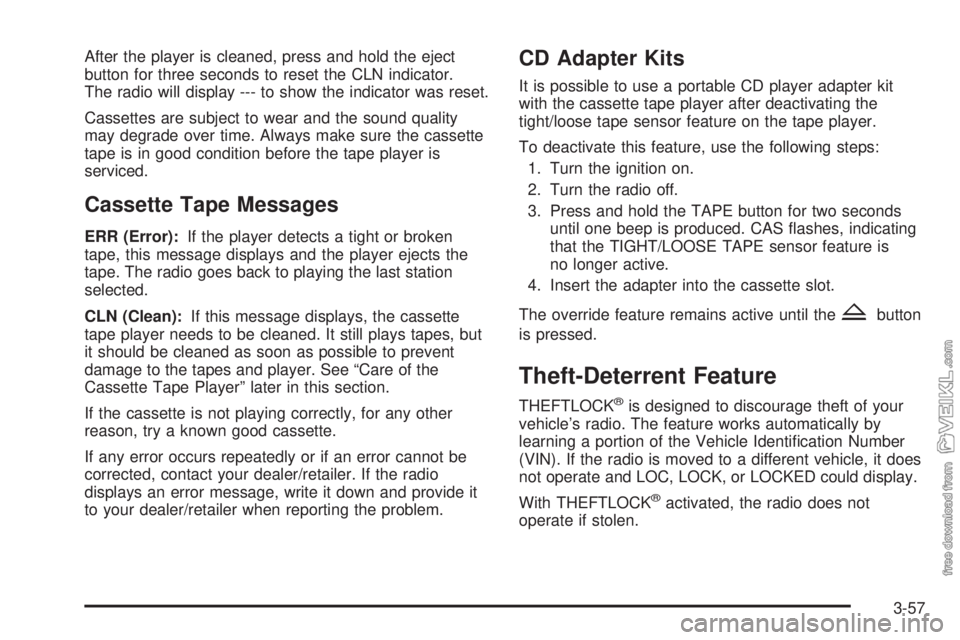
After the player is cleaned, press and hold the eject
button for three seconds to reset the CLN indicator.
The radio will display --- to show the indicator was reset.
Cassettes are subject to wear and the sound quality
may degrade over time. Always make sure the cassette
tape is in good condition before the tape player is
serviced.
Cassette Tape Messages
ERR (Error):If the player detects a tight or broken
tape, this message displays and the player ejects the
tape. The radio goes back to playing the last station
selected.
CLN (Clean):If this message displays, the cassette
tape player needs to be cleaned. It still plays tapes, but
it should be cleaned as soon as possible to prevent
damage to the tapes and player. See “Care of the
Cassette Tape Player” later in this section.
If the cassette is not playing correctly, for any other
reason, try a known good cassette.
If any error occurs repeatedly or if an error cannot be
corrected, contact your dealer/retailer. If the radio
displays an error message, write it down and provide it
to your dealer/retailer when reporting the problem.
CD Adapter Kits
It is possible to use a portable CD player adapter kit
with the cassette tape player after deactivating the
tight/loose tape sensor feature on the tape player.
To deactivate this feature, use the following steps:
1. Turn the ignition on.
2. Turn the radio off.
3. Press and hold the TAPE button for two seconds
until one beep is produced. CAS flashes, indicating
that the TIGHT/LOOSE TAPE sensor feature is
no longer active.
4. Insert the adapter into the cassette slot.
The override feature remains active until the
Zbutton
is pressed.
Theft-Deterrent Feature
THEFTLOCK®is designed to discourage theft of your
vehicle’s radio. The feature works automatically by
learning a portion of the Vehicle Identification Number
(VIN). If the radio is moved to a different vehicle, it does
not operate and LOC, LOCK, or LOCKED could display.
With THEFTLOCK
®activated, the radio does not
operate if stolen.
3-57
Page 178 of 384

Radio Reception
Frequency interference and static can occur during
normal radio reception if items such as cell phone
chargers, vehicle convenience accessories, and external
electronic devices are plugged into the accessory
power outlet. If there is interference or static, unplug the
item from the accessory power outlet.
AM
The range for most AM stations is greater than for
FM, especially at night. The longer range can cause
station frequencies to interfere with each other.
For better radio reception, most AM radio stations boost
the power levels during the day, and then reduce
these levels during the night. Static can also occur when
things like storms and power lines interfere with radio
reception. When this happens, try reducing the treble
on your radio.
FM Stereo
FM stereo gives the best sound, but FM signals reach
only about 10 to 40 miles (16 to 65 km). Tall buildings or
hills can interfere with FM signals, causing the sound
to fade in and out.
Fixed Mast Antenna
The fixed mast antenna can withstand most car washes
without being damaged. If the mast should ever
become slightly bent, straighten it out by hand. If the
mast is badly bent, replace it.
Check occasionally to make sure the mast is still
tightened to its base. If tightening is required, tighten by
hand, then with a wrench one quarter turn.
Chime Level Adjustment
The radio is used to adjust the vehicle’s chime level.
To change the volume level of the chime, press and hold
pushbutton 6 with the ignition on and the radio power
off. The volume level will change from the normal
level to loud, and HI will appear on the radio display.
To change back to the default or normal setting, press
and hold pushbutton 6 again. The volume level will
change from the loud level to normal, and LO will appear
on the radio display. Each time the chime volume is
changed, three chimes will sound as an example of the
new volume selected. Removing the radio and not
replacing it with a factory radio or chime module will
disable vehicle chimes.
3-58
Page 235 of 384
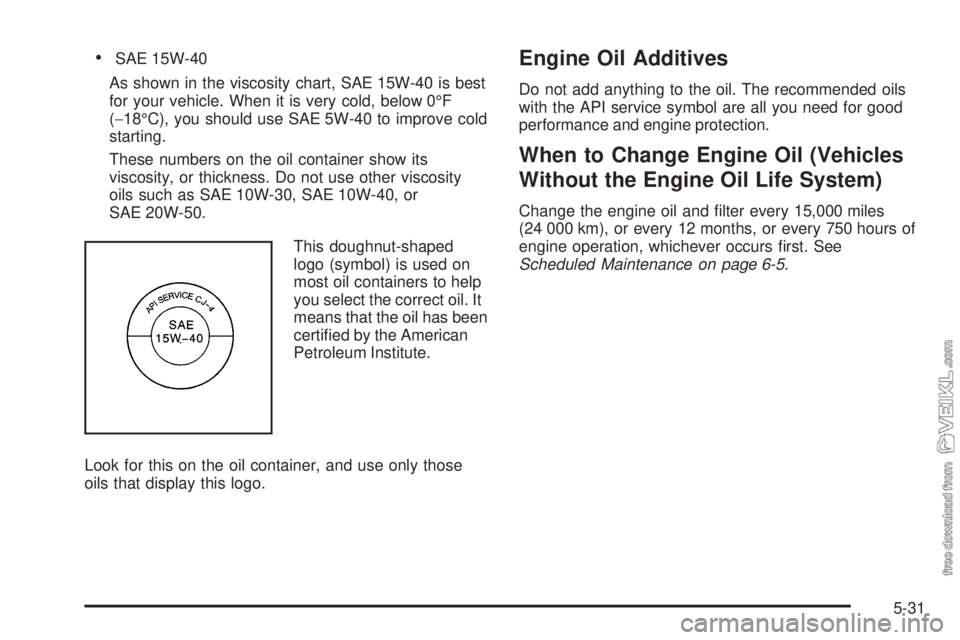
•SAE 15W-40
As shown in the viscosity chart, SAE 15W-40 is best
for your vehicle. When it is very cold, below 0°F
(−18°C), you should use SAE 5W-40 to improve cold
starting.
These numbers on the oil container show its
viscosity, or thickness. Do not use other viscosity
oils such as SAE 10W-30, SAE 10W-40, or
SAE 20W-50.
This doughnut-shaped
logo (symbol) is used on
most oil containers to help
you select the correct oil. It
means that the oil has been
certified by the American
Petroleum Institute.
Look for this on the oil container, and use only those
oils that display this logo.Engine Oil Additives
Do not add anything to the oil. The recommended oils
with the API service symbol are all you need for good
performance and engine protection.
When to Change Engine Oil (Vehicles
Without the Engine Oil Life System)
Change the engine oil and filter every 15,000 miles
(24 000 km), or every 12 months, or every 750 hours of
engine operation, whichever occurs first. See
Scheduled Maintenance on page 6-5.
5-31
Page 239 of 384
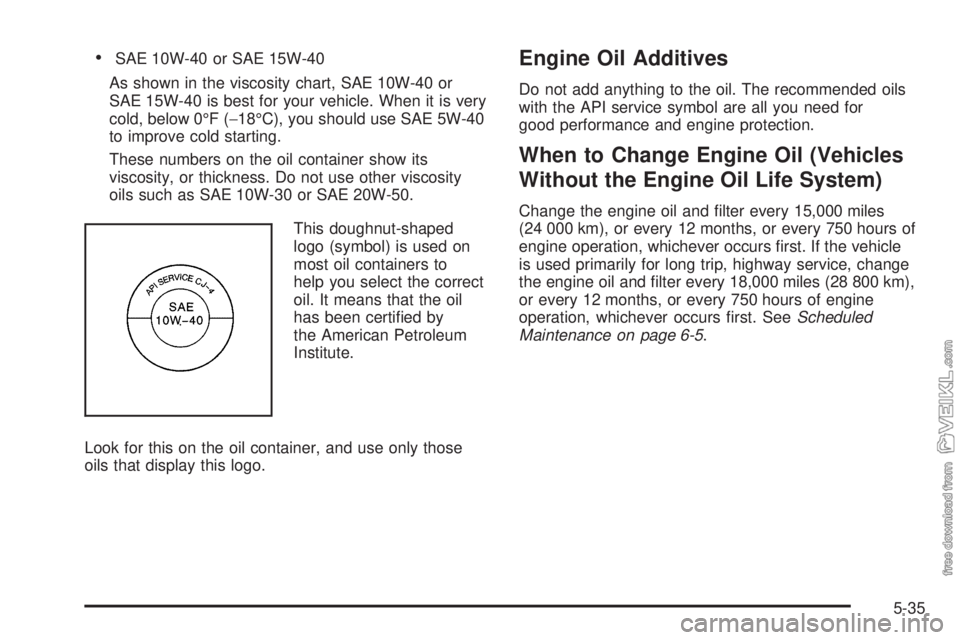
•SAE 10W-40 or SAE 15W-40
As shown in the viscosity chart, SAE 10W-40 or
SAE 15W-40 is best for your vehicle. When it is very
cold, below 0°F (−18°C), you should use SAE 5W-40
to improve cold starting.
These numbers on the oil container show its
viscosity, or thickness. Do not use other viscosity
oils such as SAE 10W-30 or SAE 20W-50.
This doughnut-shaped
logo (symbol) is used on
most oil containers to
help you select the correct
oil. It means that the oil
has been certified by
the American Petroleum
Institute.
Look for this on the oil container, and use only those
oils that display this logo.Engine Oil Additives
Do not add anything to the oil. The recommended oils
with the API service symbol are all you need for
good performance and engine protection.
When to Change Engine Oil (Vehicles
Without the Engine Oil Life System)
Change the engine oil and filter every 15,000 miles
(24 000 km), or every 12 months, or every 750 hours of
engine operation, whichever occurs first. If the vehicle
is used primarily for long trip, highway service, change
the engine oil and filter every 18,000 miles (28 800 km),
or every 12 months, or every 750 hours of engine
operation, whichever occurs first. SeeScheduled
Maintenance on page 6-5.
5-35
Page 355 of 384
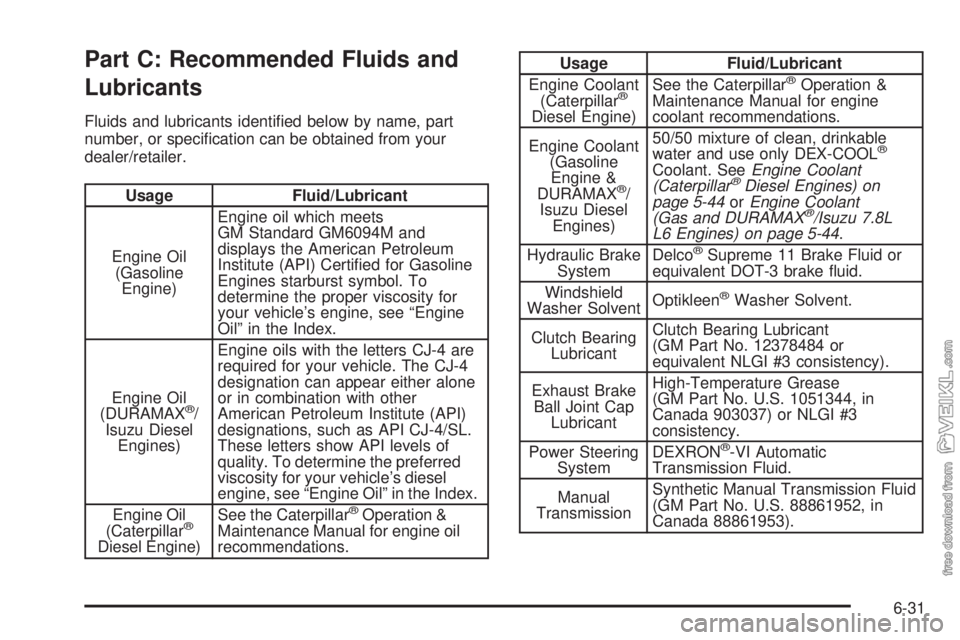
Part C: Recommended Fluids and
Lubricants
Fluids and lubricants identified below by name, part
number, or specification can be obtained from your
dealer/retailer.
Usage Fluid/Lubricant
Engine Oil
(Gasoline
Engine)Engine oil which meets
GM Standard GM6094M and
displays the American Petroleum
Institute (API) Certified for Gasoline
Engines starburst symbol. To
determine the proper viscosity for
your vehicle’s engine, see “Engine
Oil” in the Index.
Engine Oil
(DURAMAX
®/
Isuzu Diesel
Engines)Engine oils with the letters CJ-4 are
required for your vehicle. The CJ-4
designation can appear either alone
or in combination with other
American Petroleum Institute (API)
designations, such as API CJ-4/SL.
These letters show API levels of
quality. To determine the preferred
viscosity for your vehicle’s diesel
engine, see “Engine Oil” in the Index.
Engine Oil
(Caterpillar
®
Diesel Engine)See the Caterpillar
®Operation &
Maintenance Manual for engine oil
recommendations.
Usage Fluid/Lubricant
Engine Coolant
(Caterpillar
®
Diesel Engine)See the Caterpillar
®Operation &
Maintenance Manual for engine
coolant recommendations.
Engine Coolant
(Gasoline
Engine &
DURAMAX
®/
Isuzu Diesel
Engines)50/50 mixture of clean, drinkable
water and use only DEX-COOL
®
Coolant. SeeEngine Coolant
(Caterpillar®Diesel Engines) on
page 5-44orEngine Coolant
(Gas and DURAMAX
®/Isuzu 7.8L
L6 Engines) on page 5-44.
Hydraulic Brake
SystemDelco
®Supreme 11 Brake Fluid or
equivalent DOT-3 brake fluid.
Windshield
Washer SolventOptikleen
®Washer Solvent.
Clutch Bearing
LubricantClutch Bearing Lubricant
(GM Part No. 12378484 or
equivalent NLGI #3 consistency).
Exhaust Brake
Ball Joint Cap
LubricantHigh-Temperature Grease
(GM Part No. U.S. 1051344, in
Canada 903037) or NLGI #3
consistency.
Power Steering
SystemDEXRON
®-VI Automatic
Transmission Fluid.
Manual
TransmissionSynthetic Manual Transmission Fluid
(GM Part No. U.S. 88861952, in
Canada 88861953).
6-31